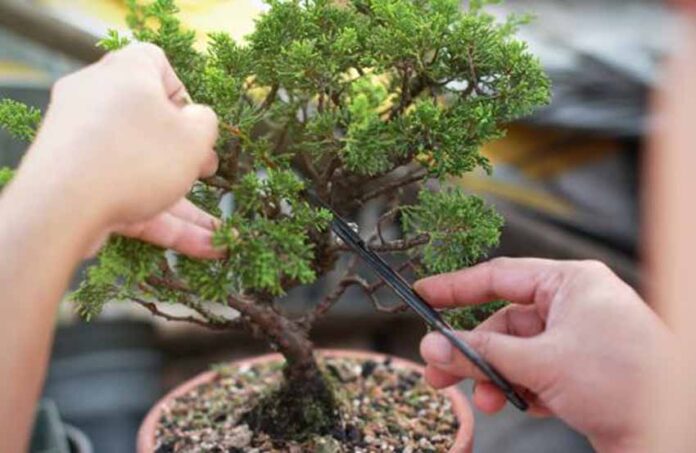Recently, our houses have become our homes, our schools, our offices, and nearly our entire world with factors forcing us to remain indoors. When you think of your landscape and the joy nature brings to your life, it doesn’t always have to be outside. And we aren’t talking about just flowers and herbs. There are many options for sprucing up your interior home-scape, pun intended. Some of our favorites, here at Mr. Tree, are small ornamental trees that can make your living room or den feel like a relaxing getaway. While there’s a plethora of options to choose from, here are five types of trees that are a great starting point.
1. Japanese Maple:
When thinking of a colorful small ornamental tree to consider bringing into your home, look no further than the Japanese maple. The Japanese maple has many varietals with striking fall colors. While they are already smaller trees in general, they will also self-stunt, meaning their size will be limited when their roots are confined to a smaller space, like an indoor container.
Not only are these beautiful trees to bring into your home, but they are also relatively easy to care for. As Japanese maples don’t require a lot of pruning and will naturally create aesthetically appealing shapes, you can cross this off your yearly to-do list. They require regular watering and will need to be placed in an area with balanced lighting, as too much can damage the leaves and not enough could prevent some of the more colorful varietals from being as vibrant as expected.
Varietals of Japanese Maple:
Some varietals to consider when searching for a way to liven up your home include the elegant Acer palmatum ‘Butterfly’ with its grey-green and creamy white–edged leaves; the Acer shirasawanum ‘Autumn Moon’ with colors ranging from pinkish-orange in the spring to orange and red in autumn; or the Acer japonicum ‘Green Cascade’ with its compact dome and an explosion of yellow, orange, and red leaves in the fall.
All three of these varietals will remain less than six feet tall and four feet in diameter when planted in a container. Another upside, no part of the Japanese maple is toxic to pets—except horses—meaning you can rest easy in the event you see your cat nibbling on a leaf.
2. Weeping Fig or Ficus benjamina:
This tropical tree is a very popular indoor staple. Often listed in stores as a ficus tree or just a ficus, this flowering tree is native to Asia and Australia. Part of its popularity as an indoor tree is due to its ability to endure indoor conditions rather well. The weeping fig can tolerate low-light more so than other indoor trees and can be sustained with moderate watering. This flowering tree has glossy dark green leaves at maturity, a smooth light gray trunk, and simple flowers of varying colors depending on the cultivar. While the weeping fig can reach heights of up to 60 feet when planted outdoors, when potted indoors, this tree is not likely to exceed 10 feet.
3. Calamondin Orange Tree or Citrus mitis:
For the homeowner wanting to appeal to their senses of sight, smell, and even taste, the calamondin orange tree may be the perfect tree species to bring into your home. This small citrus tree thrives quite nicely in the heated indoors and produces fragrant white flowers before fruiting, which will naturally make your space smell incredible.
This Philippine native caps out anywhere between three and six feet, perfect for bringing some life into your kitchen. The highly acidic fruit it produces, the Philippine lime, while not pleasantly digested on its own, can be used to marinate or season fish, fowl, and pork. This fruit is also popularly made into marmalade. With this small ornamental tree, you will bring more than just visual joy into your home.
4. Pygmy Date Palm or Phoenix roebelenii:
If you are considering a more tropical look to your indoor home-scape, consider the pygmy date palm. This subtropical palm does well in cooler indoor climates. It has long, thin leaves and an attractively textured trunk. When grown indoors, this tree can reach about five to six feet tall. Since it prefers medium light, remember to place it somewhere with some protection from the heat of direct sunlight. This tree prefers moist, well-drained soil and does best with infrequent repotting, so be sure to consider its potting container early on.
5. Bonsai:
A small ornamental tree that is very popular to bring inside the house, is the bonsai. Bonsai is actually a Japanese art form utilizing cultivation techniques to produce small potted trees that mimic the shape and scale of full-sized trees. The trees are actually many different varieties grown in the specific style of bonsai. Some may be junipers, boxwood, or Chinese elm, but due to the art form, they share similarities.
Bonsai trees are planted in shallow containers and come from an established source, like the cutting from a tree. The appeal of bonsai trees not only includes their shapes, but also the psychological benefits of caring for them. Since these trees require regular care and upkeep, including pruning, leaf trimming, repotting, and regular watering, maintaining a bonsai can provide a great sense of relaxation from a focused endeavor and pride in the continued health and vitality of the tree. Since the size of bonsais can also vary, these can be great accents on a desk, a counter, or a focal point for your room.
Now that you have an idea of some great small ornamental trees to bring indoors, if you’re as excited as we are about adding one to your indoor space and are ready to start looking at plants, consider stopping by one of the many nurseries in Portland. You’re sure to find some or even all of the trees we have listed here. Once you have procured your indoor plants, if you need advice or assistance caring for your trees and ensuring your home-scape is just as healthy as your landscape, remember, you can always reach out to the trained arborists at Mr. Tree Service, who are always here to help.
Read More:
How to prepare your garden for spring?
5 Effective Ways To Increase Home Value







